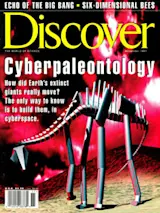Although Ronald Reagan’s dream of an orbiting fleet of space weapons to shield us from nuclear attack never materialized, several projects of the former Star Wars program have inspired somewhat more mundane research. One recent and rather humble spin-off had its origins as a sort of orbiting pellet gun that would shred enemy missiles with a hail of high-speed projectiles. While no weapons have come of this, some engineers at Brookhaven National Laboratory on Long Island have managed to scale down the technology to a more peaceful level: they’ve invented a quiet jackhammer.
The jackhammer consists of a ten-foot-long cylinder (the next prototype should be half that length) that houses a freely sliding piston inside a narrow tube. Pressurized air flows into the tube just behind the piston. In front of the piston is helium gas. As the pressurized air drives the piston into the helium, says Robert Hall, head of the engineering technology division at Brookhaven, the piston sets up a pressure wave in the helium. The wave blows down a muzzle and hits a bean-size steel projectile, which shoots out the end of the jackhammer at 3,000 feet per second--almost three times the speed of sound.
A single pellet from the gun can break up more than a square foot of concrete. Unlike a regular jackhammer, the Brookhaven version doesn’t raise any dust--the pellets, which lose all their energy on impact, don’t pulverize concrete into a powder but break it up into pebble-size fragments. And by attaching a set of baffles to the end of the barrel-- similar to a silencer on a rifle--Hall says his jackhammer is less noisy than an idling car engine.
Hall and his team are now working on a more advanced model. With expected projectile speeds of up to 10,000 feet per second, it will be able to cut the thick steel rods found in reinforced highway concrete. Hall says the jackhammer prototype will begin ripping up streets in New York City sometime next year.














